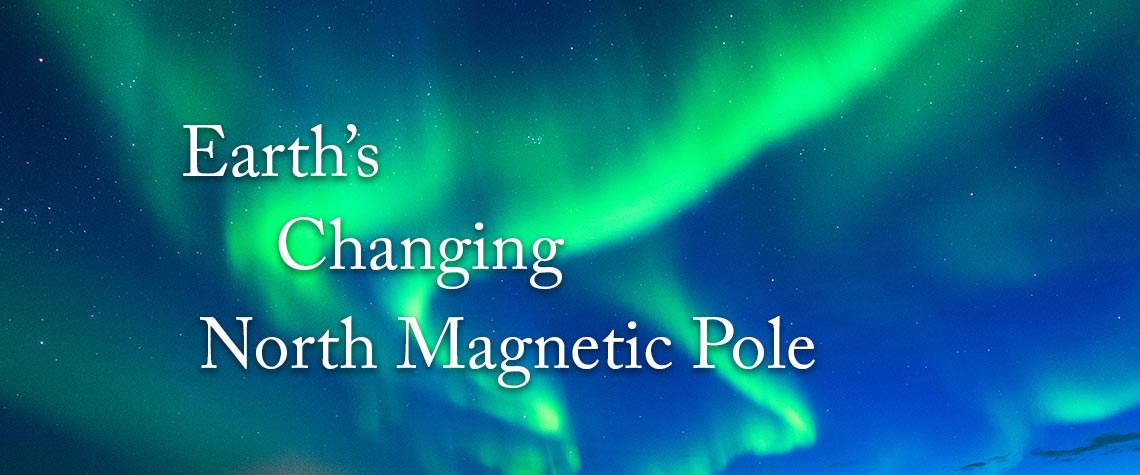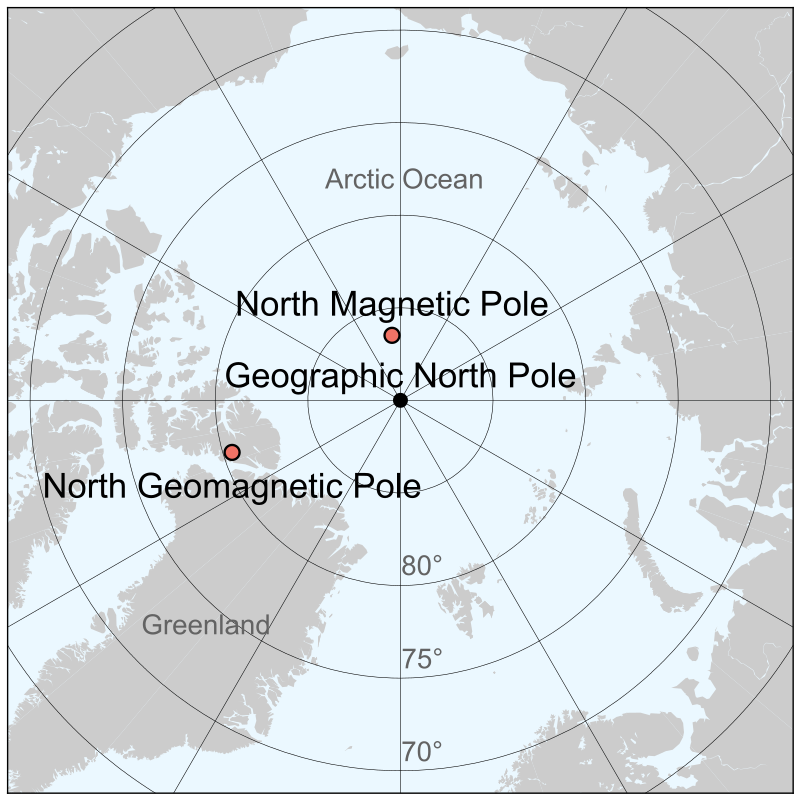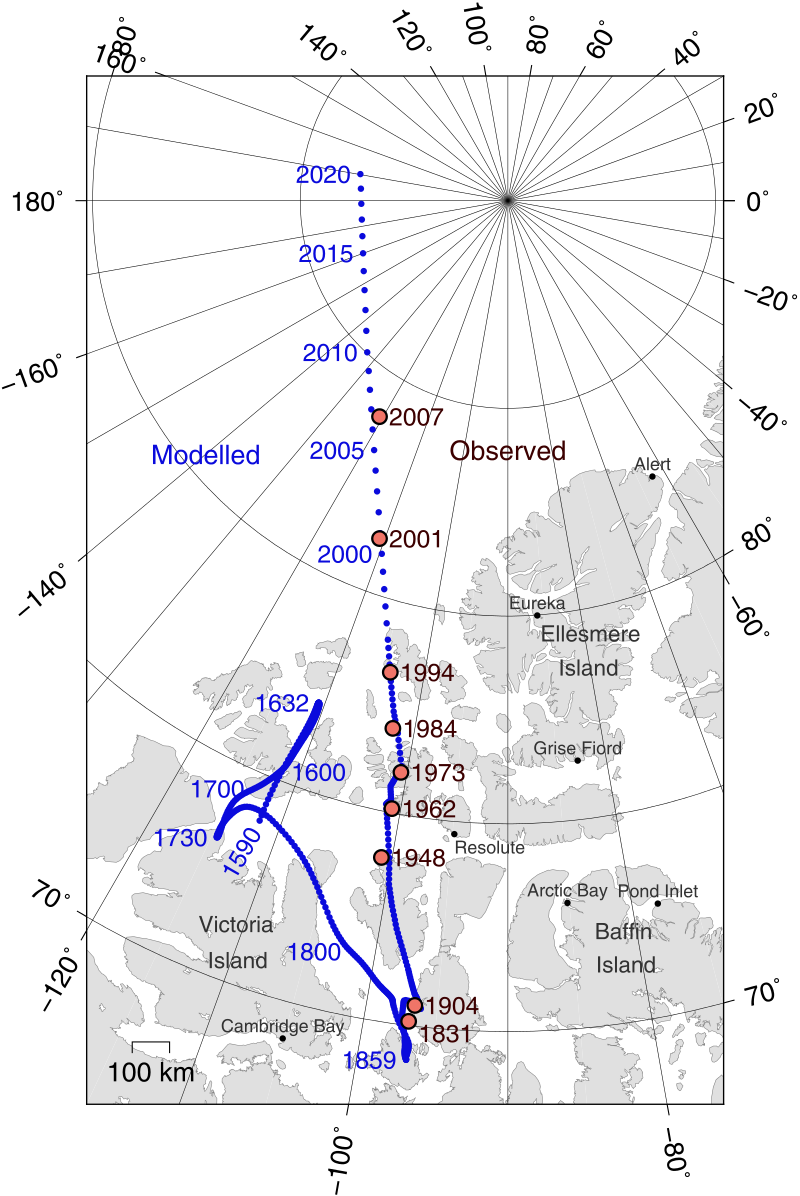Page 2


The North Magnetic Pole and its Movements
By Karl J. Aufderheide, Ph.D.
It used to be so straightforward. Lodestones had been used as navigational compasses for hundreds of years. Mariners knew that a properly mounted lodestone could be used to reliably point toward the north, even when the Sun or the stars were not visible. In the Renaissance, when the idea of magnetism was being investigated, early scientists postulated that lodestones were all reacting to a giant magnetic island located at the North Pole. (This island was even called Rupes Nigra in some old atlases). Thus, one's own lodestone compass was attracted by the giant lodestone island in the north. It made sense.
But as the understanding of magnetism and, particularly geomagnetism, advanced, the story became a lot more complex. For one thing, there is no giant lodestone magnetic island in the Arctic region to attract the needles on our compasses. Instead, the entire Earth acts as a magnet to produce a field attracting the lodestone compasses. And the mechanisms of Earth's magnetic field is still not well understood.
Some Terms Need Defining
Geographic North Pole
This is essentially the rotational axis of the Earth. Navigators are interested in this, because all their maps and charts are constructed and oriented on that axis of reference. Our astronomical charts are based on this orientation as well. On the opposite side of the Earth, 180° from Geographic North, is the Geographic South Pole.
Magnetic North Pole
This is the spot in the northern hemisphere where the magnetic field lines of the Earth point downward, vertically. This is sometimes known as the Magnetic Dip Pole, because a dip magnet points vertically at its location. Its counterpart, the South Magnetic Pole, is not precisely 180° away from the North Magnetic Pole, because the Earth's magnetic field is not symmetrical. The North Magnetic Pole is near, but not identical to, the Geographic North Pole.
Geomagnetic North Pole
This is the best fitting first-order approximation of the magnetic north pole of the Earth, assuming that the entire planet is a simple dipole bar magnet. Because the Earth's magnetic field is not a simple dipole, the estimated and observed spot for the Geomagnetic North Pole is not identical to the North Magnetic Pole, nor to the Geographic North Pole. The South Geomagnetic Pole is also not exactly 180º away from the North Geomagnetic Pole, again because the Earth's magnetic field is not symmetrical.
Current Pole Positions

Current map showing recent locations of the
Geographic North Pole,
the North Magnetic Pole,
and the apparent North Geomagnetic Pole.
Image Source: Wikipedia
The Magnetic Field
The mechanism of how the Earth's magnetic field is generated is not completely understood. The current working theory is the dynamo model, which postulates that movement of molten iron in the outer part of the Earth's core generates the magnetic field we experience. Convectional movement of this molten iron between the solid inner core and the solid mantle of the Earth, along with electrical interactions among the metallic components in the outer core, plus rotation of the planet, combine to generate a magnetic field that is the basis for the field of the entire planet. Although the dynamo model attempts to resolve the resulting projected field into a dipole, the actual expressed magnetic field is multipolar, so a comprehensive explanation of the Earth's magnetic field is still being sought.
The Earth's magnetic field has significance well beyond its ability to orient compasses. The field lines of the Earth extend well into outer space, creating what is known as the magnetosphere. This protects the Earth from the solar wind and other disruptions in the local space environment so our atmosphere isn't blown away, as it appears to have been in the history of Mars.
Movements of the Magnetic Poles
The dynamic nature of generation of the Earth's magnetic field has a number of consequences. The Magnetic Poles are not antipodal (180° apart on the sphere of the Earth) to each other; the Geomagnetic Poles are also not precisely opposite to each other on the globe. It is apparent that the Earth's core is not symmetrical and therefore the projection of the magnetic field generated by the core will not be symmetrical. Local anomalies in the Earth's crust can also influence local magnetic alignment. Furthermore, the location of the Poles are not fixed, but they both progressively move about, relative to the location of the Geographic Poles.

Observed and projected movement of the North Geomagnetic Pole in historical times.
Image Source: Wikipedia article
Short Term
Within historical times, magnetic poles have been observed to shift. In the past 180 years, the North Geomagnetic Pole has shifted westward at an average rate of 0.05° to 0.1° per year. As the map shows, the location of the Geomagnetic Pole has shifted significantly. For those who navigate by compass, though, the shift is not so significant as to disrupt one's planned routes. Periodic adjustment of the magnetic declination values is about all that would be necessary to avoid major errors. The shift in location appears to be the product of subtle changes in the location and speed of movement of dynamo components over time, but there appears to be a general trend to maintain the magnetic poles reasonably close to the geographical/rotational poles.
Long Term
During volcanic eruptions, magnetic components in the liquid rock will orient to the magnetic field as the lava cools and hardens. The orientation of the magnetic field at the time of lava cooling is preserved in the rocks and can be determined during geological analysis. A location with regular eruptions, such as the mid-ocean Atlantic Ridge system, provides a record, over geological time, of the status of Earth's magnetic field.
Changing Magnetic Poles
For the past 3 billion years or so, the magnetic field of the Earth has changed poles, so that the North Magnetic Pole becomes the South Magnetic Pole, and vice versa. The periodicity of these changes appear to be random: 183 reversals have been documented in the last 83 million years. The last reversal occurred 780,000 years ago. The duration of a reversal is estimated to be 1,000 to 10,000 years. The overall magnetic field of the Earth does not disappear during these periods of reversal, although it does become weaker and might become chaotic during the interval.
The remaining magnetosphere field is still apparently enough to protect the Earth and its atmosphere from solar wind erosion. There is no understanding of what might trigger a magnetic pole reversal, and only weak understanding of what happens in the core of the Earth during a reversal.
Geomagnetic Reversal - Biological Consequences?
Many animals do show sensitivity to the magnetic field of the Earth. This is especially apparent in migratory species (e.g., birds and some insects) that might have to navigate when the sky is not visible. Furthermore, there are real concerns about increased solar wind and cosmic ray bombardment of the surface of the Earth, leading to damage to species. Attempts, however, to correlate periods of extinction of species to the times of pole reversals show little or no statistical relation. So there is no evidence that a magnetic pole reversal would lead to a catastrophic extinction of life. The Cretaceous-Paleogene extinction event some 65 million years ago, triggered by a massive meteor strike, is not associated with a magnetic field reversal.
In recent years some attention has been focused on a progressive weakening of the current magnetic field strength, along with the fairly rapid movement of the North Magnetic Pole, leading to the concern that we might be “due” for another geomagnetic field reversal. Given our current understanding of the random nature of field reversals, and lack of any evidence of significant biological consequences of those reversals, we might reserve some skepticism about whether any catastrophes would result if a reversal began.
Major resource: Various Wikipedia articles on magnetic poles, magnetic field, the magnetosphere, and the field reversal phenomenon.